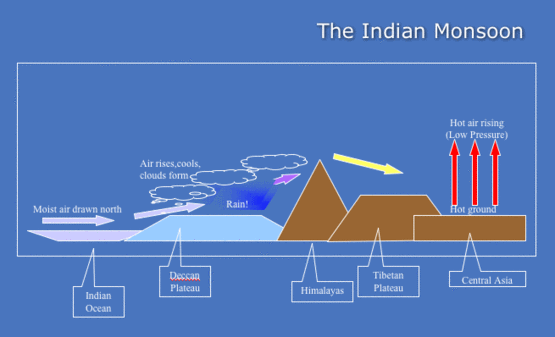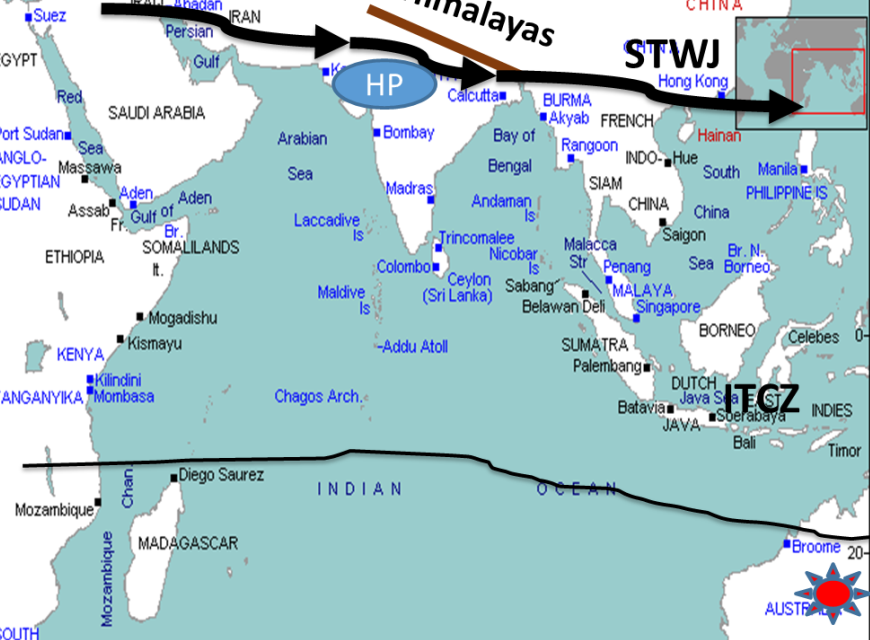-
Chapter 4: INDIAN SEASONS
Introduction
SEASONS IN INDIA
Winter season, mid-December to mid-March
Hot weather season, mid-March to May.
Rainy season, June to September
Season of retreating monsoon, October to mid-December.
There are three seasons in India:
summer, winter and monsoon. The climate of India is essentially sub-tropical monsoonic. The word 'monsoon' has been derived
from the Arabic word "Mausim" which means 'season'. Originally, the word 'monsoon' was, used
by Arab navigators several centuries ago, to describe a system of seasonal reversal of winds along
the shores of the Indian Ocean, especially over the Arabian Sea, in which the winds blow from the
south-west to north-east during the summer season and from the north-east to south-west during
the winter season.
Monsoon is a unique weather phenomenon due to seasonal reversal of winds.
Features of Indian Monsoon
Monsoon has following features:
1. Sudden onset
2. Gradual advance
3. Gradual retreat
4. Variation – temporal and regional
INDIAN MONSOON
Monsoons are a complex meteorological phenomenon. Experts of meteorology have developed a number of concepts about the origin of monsoons. Some of the important concepts about the origin of monsoons have been given as under
The Thermal Concept of Halley :
The primary cause of the annual cycle of the Indian monsoon circulation was the differential heating effects of the land :and the sea.
Monsoons are the extended land breeze and sea breezee on a large scale, produced by the differential heating of continents and ocean basins. During the summer season in the Northern Hemisphere, when the Sun's rays are vertical over the Tropic of Cancer, the huge landmass of Asia heats quickly and develops a strong low pressure centre near Lake Baikal (Siberia) and Peshawar (Pakistan). This thermal low extends up to 700 mb. Moreover, the pole-ward shift of the Inter-Tropical Convergence Zone (ITCZ) to a position over southern Asia reinforces the thermally induced low pressure centre. In comparison to this, the pressure over the adjacent water of the Indian and the Pacific Oceans is relatively high. Under these conditions, a sea-to-land pressure gradient develops. Consequently, the surface air flow is from the high pressure over the oceans towards the low pressure areas over the heated landmass. Under the extreme low pressure condition on land, the wind from the southern part of the Indian Ocean (south of Equator) is attracted towards the subcontinent of India.
The air coming from oceans towards land is warm and moist. When land barriers like mountain ranges and plateaus come in the way of the moisture-laden winds, they ascend and result into saturation, condensation, and precipitation
In the Northern Hemisphere during winter season, there develops high pressure areas near Baikal Lake (Siberia), and Peshawar {Pakistan}. As compared to these high pressures, the Indian Ocean and the Pacific Ocean (south of Japan) remain relatively warm, having low pressure areas.
Consequently, there is an outflow of air from the high pressure of the land to the low pressure areas of the oceans. The air blowing from high pressure areas of land towards the sea is cold and dry. This cold and dry air is incapable of giving precipitation unless it comes into contact with some water body (ocean/sea)
Criticism of The Thermal Concept of Halley
The low pressure areas that develop over the continents during the summer season in the Northern Hemisphere are not stationary. These low pressure areas change their position (location) suddenly, This sudden change in the low pressure areas are not exclusively related to low thermal conditions.
Had the monsoon been thermally induced, there would be anti-monsoon circulation ill the upper air of the troposphere, which is lacking.
Halley did not take into consideration the Coriolis effect of rotation of the earth on its axis. On a rotating earth, the wind has a tendency to move towards its right in the Northern Hemisphere and towards its left in the Southern Hemisphere.
The role of latent beat passing into the atmosphere through water vapour was also not considered by Halley; water vapour also plays an important role in the origin and development of monsoons.
The modern researches in meteorology have shown that the monsoon rainfall is not wholly orographic. They are an amalgamation of convectional, orographic and cyclonic rainfall.
Indian Monsoon
Stage 1:
The apparent movement of the sun in northern hemisphere in summer is seen. This heats the Tibetan plateau and the air rises upwards. This creates a Tropical Eastern Jetstream which descends at Madagascar and creates a high pressure zone there. An inter tropical convergence zone [ITCZ] formed at equator moves to Tibetan plateau.

Fig 1: Indian monsoon
Stage 2:
The Somali jet stream intensifies the Somalian ocean current during summer. Stronger the Somalian current better the monsoon.
Stage 3:
Sub tropical westerly jet maintains high pressure over North India. The STWJ is bifurcated by the Himalayas into two branches.

Fig 2: STWJ and Himalayas
The summer see apparent movement
of the sun and heating of the Tibetan plateau. This creates a
low pressure belt over Tibet.
The STWJ still continues to be
over South Himalayas and it resists the monsoon winds.
In this time there is local
convectional rainfall in Bengal, Bihar called Kalbaisakhi ,
mango showers. These are pre monsoon thunder showers.
Then the STWJ southern branch moves over north and STWJ withdraws from the Indian subcontinent. If this branch reestablishes then monsoon break is seen.
Stage 4: Indian Ocean
Dipole
Low pressure conditions over Australia and Tibetan plateau and high pressure over Madagascar create an Indian ocean dipole. A strong dipole pushes monsoon winds towards Indian subcontinent.

Fig 3: Indian Ocean Dipole
Stage 5: onset of
monsoon
The monsoon winds have two
branches Arabian and Bay of Bengal. The Arabian branch moves
over western ghats and is blocked. This brings heavy rainfall
over western region.
The SW Arabian branch isn't
blocked by Aravallis so less monsoon over Rajasthan. The gap
between Vindhyas and Aravallis mean SW winds reach over to
Himachal Pradesh.
The Eastern branch of the SW
monsoon goes over Bay of Bengal and isn't blocked by the eastern
ghats. It passes through their gaps and reaches Vindhya ,
Satpuda range and Chota Nagpur plateau. This gives rainfall to
the Eastern India and interiors.
The second part of the eastern branch of sw monsoon passes over north east and brings rain there.
Stage 6: retreat
monsoon
The month of September the ITCZ
retreats towards the equator from Tibetan plateau. As it passes
over the India the eastern branch of South west monsoon and
north east winds collide.
The eastern branch of South west monsoon
withdraws first. Then North East winds are off land and hence
dry but they pick moisture over Bay of Bengal and bring rain to
southern tip of India i.e. Coast of Andhra Pradesh, Tamil Nadu.
The retreating eastern branch of
South west monsoon brings
cyclones to the land.
Fig 4: Indian Monsoon
Fluctuations in Indian monsoon:
1. If the Indian ocean dipole is weak.
2. Southern oscillation is reversed or not strong.
3. SWTJ doesn’t retreat from India or comes back once again.
4. Inadequate heating of Tibetan plateau.
Solved Question Papers
Q.With reference to ‘Indian Ocean Dipole (IOD)’ sometimes mentioned in the news while forecasting Indian monsoon, which of the following statements is/are correct?
1. IOD phenomenon is characterized by a difference in sea surface temperature between tropical Western Indian Ocean and tropical Eastern Pacific Ocean.
2. An IOD phenomenon can influence an El Nino’s impact on the monsoon.
Select the correct answer using the code given below: (UPSC CSAT 2017)
1 only
2 only
Both 1 and 2
Neither 1 nor 2
Ans . B
Indian Ocean Dipole (IOD) is an event which the western Indian Ocean becomes alternately warmer and then colder than the eastern part of the Indian ocean.
A positive IOD leads to greater monsoon rainfall and more active (above normal rainfall) monsoon days while negative IOD leads to less rainfall and more monsoon break days
Q.Consider the following statements:
1. In India, the Himalayas are spread over five States only.
2. Western Ghats are spread over five States only.
3. Pulicat Lake is spread over two States only.
Which of the statements given above is/are correct? (UPSC CSAT 2017)
1 and 2 only
3 only
2 and 3 only
1 and 3 only
Ans . B
Western Ghats are spread over six States
Q.With reference to river Teesta, consider the following statements:
1. The source of river Teesta is the same as that of Brahmaputra but it flows through Sikkim.
2. River Rangeet originates in Sikkim and it is a tributary of river Teesta.
3. River Teesta flows into Bay of Bengal on the border of India and Bangladesh.
Which of the statements given above is/are correct? (UPSC CSAT 2017)
1 and 3 only
2 only
2 and 3 only
1, 2 and 3
Ans . B
Teesta merges into Brahmaputra itself rather than flowing into sea by its own
Q.If you travel by road from Kohima to Kottayam, what is the minimum number of States within India through which you can travel, including the origin and the destination? (UPSC CSAT 2017)
6
7
8
9
Ans . B
Nagaland, Kohima, Assam, W.Bengal, Odisha, Andhra Pradesh, Karnataka (or Tamilnadu), Kerala, Kottayam
Q.At one of the places in India, if you stand on the seashore and watch the sea, you will find that the sea water recedes from the shore line a few kilometres and comes back to the shore, twice a day, and you can actually walk on the sea floor when the water recedes. This unique phenomenon is seen at (UPSC CSAT 2017)
Bhavnagar
Bheemunipatnam
Chandipur
Nagapattinam.
Ans . C
Chandipur beach has a unique distinction on its own. Unlike other beaches, the sea water here recedes away from the shore line about five km twice a day, an unusual phenomenon, rarely found anywhere.
Q.Which of the following is geographically closest to Great Nicobar ? (UPSC CSAT 2017)
Sumatra
Borneo
Java
Sri Lanka
Ans . A
Sumatra seems quite closer to Great Nicobar than Sri Lanka.
Q.Mediterranean Sea is a border of which of the following countries?
Jordan
Iraq
Lebanon
Syria
Select the correct answer using the code given below: (UPSC CSAT 2017)
1, 2 and 3 only
2 and 3 only
3 and 4 only
1, 3 and 4 only
Ans . C
Mediterranean Sea doesn’t touch Jordan and Iraq
Chapter Review
Score more than 80% marks and move ahead else stay back and read again!